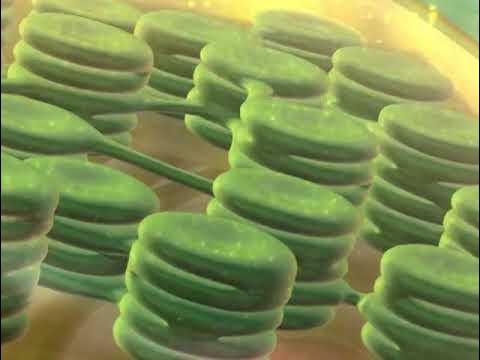La Nutrición en las Plantas
Summary
TLDRThis video explains the essential processes of plant nutrition, focusing on how plants produce their own food and maintain life. It covers key stages including absorption of water and minerals through the roots, transport via xylem, photosynthesis in chloroplasts with the help of sunlight and CO2, and cellular respiration in mitochondria to produce energy. The video also highlights gas exchange through stomata, regulating water loss while ensuring CO2 intake for photosynthesis. These interconnected processes sustain plant growth and release oxygen, crucial for all living beings.
Takeaways
- 😀 Plants are autotrophic organisms, meaning they produce their own food through processes like photosynthesis.
- 😀 Photosynthesis requires sunlight, water, carbon dioxide, and chlorophyll to produce organic matter and oxygen.
- 😀 Water and mineral salts are absorbed by the plant through its roots and the absorbent hairs.
- 😀 The absorbed nutrients form raw sap, which is transported to the rest of the plant through the xylem tissue.
- 😀 Photosynthesis occurs in plant cells with chloroplasts, especially in the green parts of the plant, due to the presence of chlorophyll.
- 😀 Stomata in the leaves regulate the intake of carbon dioxide and the release of oxygen during photosynthesis.
- 😀 Oxygen is a byproduct of photosynthesis, coming from the splitting of water molecules.
- 😀 Cellular respiration happens in the mitochondria of all plant cells, converting organic matter and oxygen into energy.
- 😀 The process of cellular respiration also releases carbon dioxide, which exits the plant through the stomata.
- 😀 Plants face a dilemma between absorbing as much carbon dioxide for photosynthesis as possible and conserving water.
- 😀 Gas exchange in plants occurs through stomata, allowing for the intake of carbon dioxide and release of oxygen and water vapor.
Q & A
What is the primary function of plants in terms of nutrition?
-The primary function of plants in terms of nutrition is to produce their own food through the process of photosynthesis. They use sunlight, carbon dioxide, water, and mineral salts to create organic matter and oxygen.
How do plants absorb water and mineral salts from the soil?
-Plants absorb water and mineral salts from the soil through the root hairs, which are located in the root. These nutrients form a mixture known as raw sap.
What is the role of xylem in plant nutrition?
-The xylem is responsible for transporting the raw sap, which contains water and mineral salts, from the roots up through the plant. It extends through the stem and branches to the green parts of the plant.
Where does photosynthesis occur within a plant, and what is its significance?
-Photosynthesis occurs within the chloroplasts of plant cells, particularly in the green parts of the plant. This process is significant because it allows plants to produce organic matter (food) using sunlight, water, and carbon dioxide.
What role does chlorophyll play in photosynthesis?
-Chlorophyll is the green pigment found in plant cells. It absorbs sunlight, which provides the energy necessary for the process of photosynthesis to take place.
What happens to the oxygen produced during photosynthesis?
-The oxygen produced during photosynthesis is released into the atmosphere through the stomata, which are small pores on the plant’s surface. This oxygen is vital for the respiration of other living organisms.
What is cellular respiration, and where does it take place in plants?
-Cellular respiration is the process by which plants convert organic matter into energy (ATP) using oxygen. It takes place in the mitochondria of plant cells.
What is the relationship between photosynthesis and cellular respiration in plants?
-Photosynthesis and cellular respiration are interconnected. Photosynthesis produces organic matter and oxygen, while cellular respiration uses oxygen and organic matter to produce energy for the plant. The byproduct of cellular respiration, carbon dioxide, is used in photosynthesis.
What is the function of stomata in plants?
-Stomata are small pores located on the surface of plant leaves. They allow for gas exchange, enabling carbon dioxide to enter for photosynthesis and oxygen to exit after cellular respiration. They also control water vapor loss in the plant.
How do plants regulate water loss while ensuring adequate carbon dioxide intake?
-Plants regulate water loss by opening and closing the stomata. When the plant needs to retain water, the stomata close, reducing water vapor loss. At the same time, they open to allow carbon dioxide to enter for photosynthesis, balancing both processes.
Outlines

Cette section est réservée aux utilisateurs payants. Améliorez votre compte pour accéder à cette section.
Améliorer maintenantMindmap

Cette section est réservée aux utilisateurs payants. Améliorez votre compte pour accéder à cette section.
Améliorer maintenantKeywords

Cette section est réservée aux utilisateurs payants. Améliorez votre compte pour accéder à cette section.
Améliorer maintenantHighlights

Cette section est réservée aux utilisateurs payants. Améliorez votre compte pour accéder à cette section.
Améliorer maintenantTranscripts

Cette section est réservée aux utilisateurs payants. Améliorez votre compte pour accéder à cette section.
Améliorer maintenantVoir Plus de Vidéos Connexes
5.0 / 5 (0 votes)






